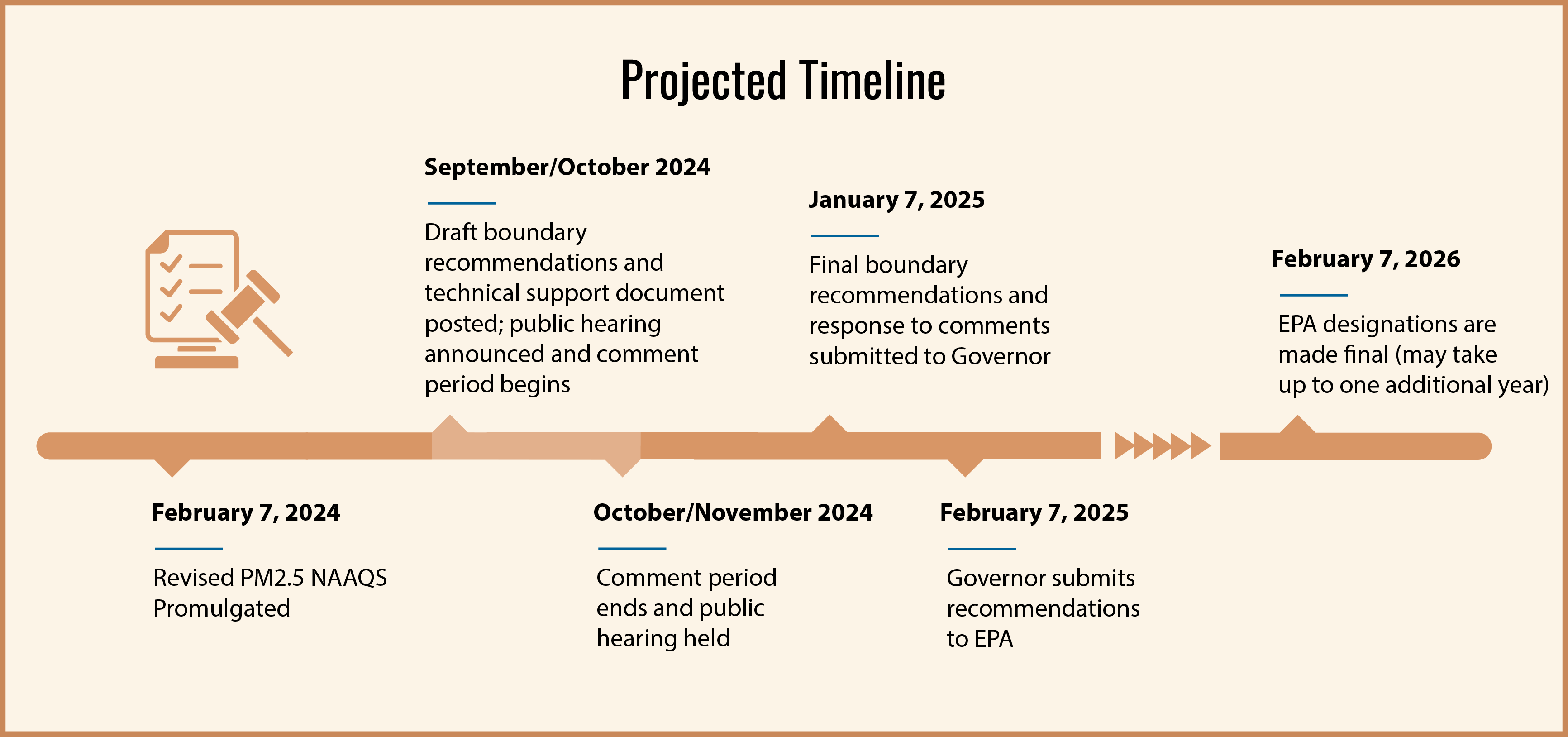AQD | National Ambient Air Quality 2024 Revision
Pursuant to A.R.S. § 49-405, ADEQ held a public comment period from Sept. 23, 2024, to Oct. 24, 2024, for its proposed 2024 PM2.5 NAAQS Boundary Recommendations Draft Report and technical support document (TSD). A public hearing was held on Oct. 24, 2024, at 11 a.m. The draft recommendations and TSD proposed areas for nonattainment, attainment, and unclassifiable designations throughout the state for the 9.0 µg/m3 NAAQS | View Public Notice >
ADEQ is evaluating comments received during the public comment period and will draft a formal response to comments. In accordance with A.R.S. § 49-405, the final proposed boundary recommendation, response to comments, and TSD will be provided to the Governor’s Office no later than Jan. 7, 2025. Pursuant to A.R.S. § 49-405(C)(4)(b), ADEQ will post the final proposed boundary recommendation, response to comments, and TSD within five days after ADEQ’s submittal to the Governor.
- ADEQ’s Proposed Draft PM2.5 Boundary Recommendation | View >
- Mapping Tool | View >
- ADEQ held two informal information sessions on Sept. 19 and 20, 2024, for the proposed boundary recommendations and supporting technical analysis that includes three areas within Arizona (portions of Maricopa County, Pinal County, and Santa Cruz County) with respect to the revised 2024 PM2.5 primary annual NAAQS | View Session Presentation >
- Stationary sources of both direct PM2.5 emissions and PM2.5 precursor pollutants may be subject to additional control requirements as a result of the revised standard.
- Precursor pollutants of PM2.5 for PM2.5 attainment areas are:
- Nitrogen oxides (NOx), and
- Sulfur dioxide (SO2).
- Precursor pollutants of PM2.5 for PM2.5 nonattainment areas are:
- NOx,
- SO2,
- Volatile organic compounds (VOCs), and
- Ammonia.
- Precursor pollutants of PM2.5 for PM2.5 attainment areas are:
- Existing Sources
- Existing sources will not need to amend their current permits as a result of the new standard, unless they undertake a modification.
- However, once EPA has designated nonattainment areas, and the nonattainment State Implementation Plan (SIP) development process is underway, air quality planning agencies will have to consider whether additional controls on existing stationary sources are necessary and should be included in the SIP.
- New Sources and Modifications
- A new source is a new industrial plant, such as a new factory or mine.
- A modification is a physical or operational change to an existing source, including installation of new equipment, which results in an increase in emissions.
- Anyone applying for a permit for a new source or modification may have to demonstrate through modeling that emissions of PM2.5 or PM2.5 precursors from the source or modification will not cause or contribute to a violation of the revised PM2.5 NAAQS.
- This requirement will apply to any source subject to the Prevention of Significant Deterioration (PSD) permit program or to Minor New Source Review (NSR).
- A source that has obtained a final permit under either of these programs before the effective date of the revised NAAQS (May 6, 2024) will be grandfathered out of this requirement.
- The NAAQS revision does not change which sources are subject to PSD or Minor NSR; rather, it requires sources and modifications already subject to those programs to model for compliance with the revised PM2.5 NAAQS.
- After an area is designated nonattainment for the revised PM2.5 NAAQS, applicants for a permit or permit revision to construct a new source or modification in the area may be subject to nonattainment NSR. Among other requirements, an applicant subject to nonattainment NSR must obtain emission reductions from other sources in the area to completely offset the increase in emissions from the new source or modification.
When EPA releases a new or revised NAAQS, the Governor of each state is required to submit recommended boundary designations to EPA, identifying all areas of the state as:
- Nonattainment (areas that do not meet the NAAQS, or areas that contribute to a nearby area not meeting the NAAQS),
- Attainment (areas that meet the NAAQS), or
- Unclassifiable (areas that cannot be classified as attainment or nonattainment based on available information).
The Arizona Governor’s recommendations for the 2024 revised annual PM2.5 primary NAAQS are due to EPA by Feb. 7, 2025.
Pursuant to Arizona Revised Statutes (A.R.S.) § 49-405, ADEQ is the lead agency assisting the Arizona Governor in making the boundary recommendations. When developing the initial boundary recommendations, ADEQ will consider EPA’s five factors: air quality monitoring data, emissions and emissions-related data, meteorology, geography/topography, and jurisdictional boundaries.
EPA will make the final decision regarding how areas are classified. If EPA decides that it is necessary to modify a state's recommendation, then EPA will notify the state at least 120 days prior to finalizing the area designations to allow the state an opportunity to comment on the potential modification. EPA has until Feb. 7, 2026, to finalize the initial area designations, unless there is insufficient information. In such circumstances, EPA may take up to 1 additional year to make the designation decisions (i.e., no later than 3 years after promulgation of the standard).
The timeline for developing the boundary recommendations is summarized in the following graphic for the 2024 revised annual PM2.5 primary standard.


